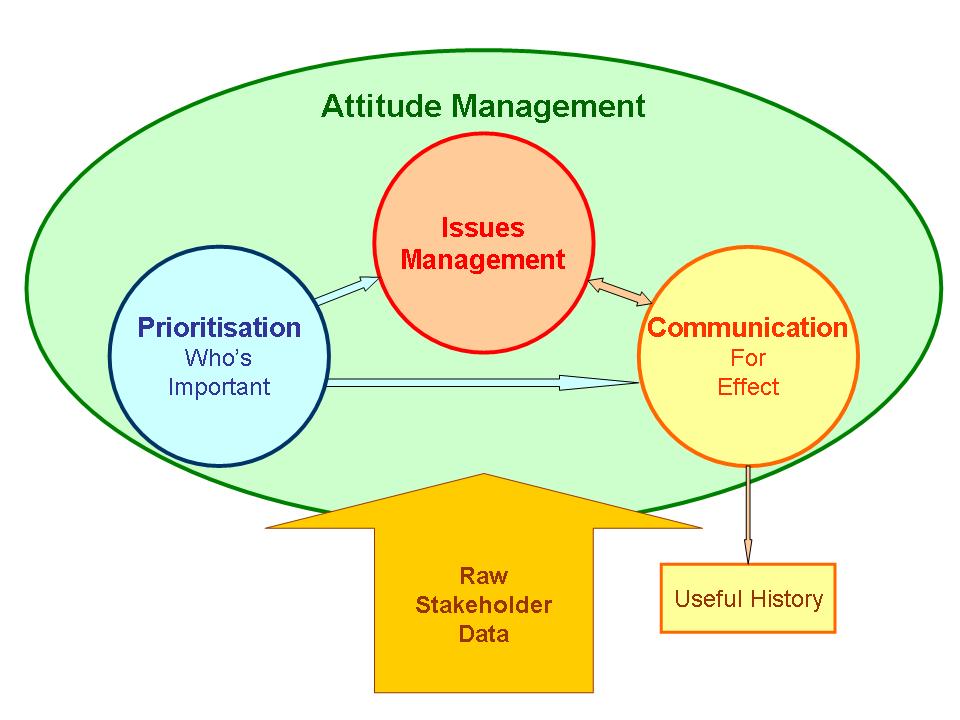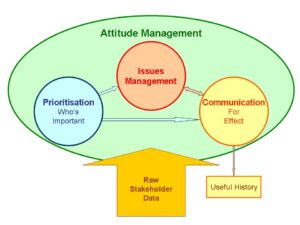This post will look at the various dimensions of a stakeholders ‘attitude’ towards you and your project and how these will influence the project’s chance of success.
Attitude is derived from perceptions, in this context the stakeholder’s perception of the project and how its outcomes will affect the stakeholder’s interests. Fortunately, perceptions are negotiable and can be changed by effective communication. Change perceptions and a change in attitude will follow.
There are two key dimensions to attitude considered in my research. The first is how supportive or opposed the stakeholder is towards the project. The other is how receptive the stakeholder is to communication from the project team. Whilst receptiveness may seem less important, you cannot change a stakeholder’s level of supportiveness if they refuse to communicate with you.
Levels of supportiveness can range from active opposition to active support. For each of the important stakeholders, the project team needs to understand the stakeholder’s current level of support and then determine a realistic optimum level to facilitate the project’s success. What represents a realistic optimum varies. Environmental activists can never be realistically expected to support a new road through a wilderness area; in this circumstance the realistic optimum may be passive opposition (as opposed to active opposition) and a communications plan developed to negotiate an outcome that the environmentalists can live with. On the other hand your project sponsor should be an active supporter, if the person is merely a passive supporter communication needs to be planned to engage the stakeholder in actively supporting the success of her project.
Achieving either of these objectives needs open communication. If the stakeholder is unwilling to communicate (either because they really don’t like you or they are just too busy) ways need to be devised to open different channels. This may involve using other stakeholders in the network around the project to open the communication, using someone else on your team as the messenger, changing the way you communicate or just plain persistence.
One of the key factors within your control that will influence the effectiveness of your communication is your personal credibility. A small amount of credibility comes from your position as the ‘project manager’; the rest has to be earned. For more on credibility see: http://stakeholdermanagement.wordpress.com/2013/04/27/733/. However, if you cannot gain credibility with a particular person because of their ‘filters’, make sure you find a credible messenger to carry your communication.
Communication is a two way process. Only after communication channels are open can you start to listen to the other person and understand their needs, concerns or ambitions. Once these are known, you are then in a position to either explain how the current project meets those needs or consider risk mitigation strategies to modify the project to reduce issues and enhance opportunities.
The whole point of stakeholder management is to optimise the overall attitude of the stakeholder community to allow the project to succeed. This requires:
- A focus on the important people at ‘this point in time’;.
- Understanding and managing ‘their issues’, and;
- Communicating to achieve the desired changes in attitude – communicating for effect!
This is the focus of my on-going research and work and is summarised in the diagram below…
Communicating for effect mean that where people are at or above the optimum target attitudes, the purpose of your communication is to maintain the status quo and less important stakeholders who are below your desired optimum need as much effort as can be spared from your limited resources. But, important stakeholders who are below optimum need heroic communication efforts to change the situation and maximise the project’s chance of succeeding. You focus your communication efforts where the need is greatest.
Remember, a very significant proportion of the risks around most projects are people based. The only way to identify, manage and/or mitigate these risks is by effective two way communication designed to effect changes in attitude – more on this later.






Pingback: Resource Management Blog - Latest Pmp Training News